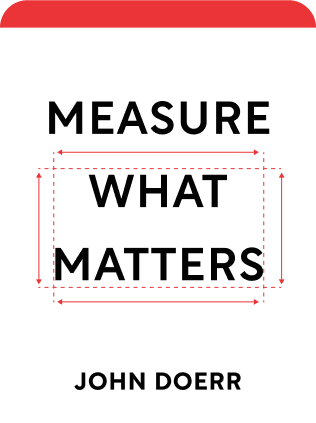

This article is an excerpt from the Shortform summary of "Measure What Matters" by John Doerr. Shortform has the world's best summaries of books you should be reading.
Like this article? Sign up for a free trial here .
What are the OKR superpowers? Why do you need them?
The four OKR superpowers are the four main OKR skills that help guide you through the OKR process. You can use the four OKR superpowers to create the best OKRs, and implement your plans.
Keep reading to find out about the four OKR superpowers.
Four OKR Superpowers
The primary benefits of OKRs come from their four superpowers: focus, align, track, and stretch.
Superpower #1: Focus
First of the OKR superpowers is Focus. OKRs clarify your focus by limiting you to 3-5 objectives at a time. Remember that every time you commit to something, you make yourself unavailable to commit to something else, so choose your commitments wisely. Once you’ve chosen where to put your focus, commit to those objectives.
OKRs also clarify your focus by limiting you to 3-5 key results per objective. Because the success of your key results must result in the success of your objective, you need to create key results carefully. For example, the three sets of key results (KRs) below are all proposed paths toward the objective of winning the Indy 500, but only one set is focused enough to get you there.
| Weak KRs | So-So KRs | Strong KRs |
| Objective: Win the Indy 500.KR #1: Achieve a faster lap speed.KR #2: Decrease time during pit stops. | Objective: Win the Indy 500.KR #1: Achieve a lap speed that’s 2% faster.KR #2: Decrease time during pit stops by an average of 1 second/stop. | Objective: Win the Indy 500.KR #1: Achieve a lap speed that’s 2% faster.KR #2: Decrease time during pit stops by an average of 1 second/stop.KR #3: Decrease pit stop errors by half.KR #4: Spend 1 hour/day practicing pit stops. |
In the example above, the weak key results aren’t specific enough. The so-so key results are better because they’re measurable and specific, but they don’t specify how to decrease pit-stop time the way the strongest key results do.
Superpower #2: Align
Second on the list of Measure What Matters superpowers is Align. OKRs are good at aligning companies because OKRs are always public. CEOs can look at the goals of their executives, managers, and junior staff, and junior staff can (and should) look at the goals of their bosses and the CEO. This allows people to coordinate their goals with those of the company and their peers.
Use Both Top-Down and Bottom-Up Alignment
Generally, there are two approaches to alignment: top-down and bottom-up. In the top-down approach, directives start with the CEO and cascade down through the ranks to the junior employees. In the bottom-up approach, junior employees working on the frontlines, the people who have the most access to customers and product issues, identify pressing needs and relay them up the chain of command to the CEO.
The most effective companies are aligned in both directions, with half of an employee’s objectives coming from the top and half set by the employee herself. If you’re assigning an objective to one of your employees, make sure you clearly demonstrate how the objective connects to the company’s top priorities.
Employees should set most of their key results themselves. People who choose their goals take more responsibility for reaching them.
Superpower #3: Track
Third on the list of Measure What Matters superpowers is track. OKRs are always measurable, and at the end of each OKR cycle you score them. These scores help you track your progress, and they indicate when you need to double down on a particular goal or when you should revise or abandon it.
During the OKR cycle, check-in with your manager weekly or monthly to discuss your OKR progress and decide among four options for each goal:
Option #1: Continue the objective or key result—If everything’s going well and you’re making progress, keep going.
Option #2: Revise the objective or key result—If changes in your environment or workflow have caused the goal to get off track, update it.
Option #3: Start a new objective or key result—As conditions change, you may need to add new goals. If you already have five objectives, put one or two on the backburner to make room for the new goal.
Option #4: Stop an objective or key result—Some goals become irrelevant or impractical. Don’t stubbornly cling to a goal just because you set it. If it no longer serves your larger purpose or the company’s, toss it.
Superpower #4: Stretch
Finally, the last of the OKR superpowers is stretch. Some of your OKRs should be especially challenging. Expect “stretch OKRs” to score between 0.4 and 0.6. Setting challenging goals allows your company to continue innovating.
This is how Google distinguishes between regular objectives (“committed objectives”) and stretch objectives (“aspirational objectives”):
- Committed objectives are the goals that need to be met within a set period of time for the company to prosper. Additionally, these goals need to be 100% or near-100% complete (or receive a score of 1.0) by the deadline. Committed objectives include sales and revenue goals around product releases, customer satisfaction, and hiring.
- Aspirational objectives are goals that reflect the bigger picture, outside of day-to-day needs, and focus on big, ambitious ideas.
Google doesn’t expect everyone to achieve their aspirational objectives, and failure is built into the process—in fact, the average rate of failure at Google is about 40%.
Your company’s balance of committed and aspirational objectives will depend on your answers to the following questions:
- Do we want to break into a new market next year? Do we have some extra cash to play around with? Can we afford to make a risky bet? (If yes, favor aspirational objectives, or stretch goals.)
- Do we want to further establish our current position in the market? Are we in survival mode, just trying to stay afloat? (If yes, favor committed goals.)
Regardless of your answers, every company should have at least one or two aspirational objectives. To determine yours, ask, “What would incredible look like for our company?” When you answer these questions, consider your Measure What Matters superpowers.

———End of Preview———
Like what you just read? Read the rest of the world's best summary of John Doerr's "Measure What Matters" at Shortform .
Here's what you'll find in our full Measure What Matters summary :
- How Google uses OKRs to rally 100,000 employees in the right direction
- How to avoid setting useless OKRs, and how to set great ones
- Key subtle behaviors your team must master to make OKRs work






